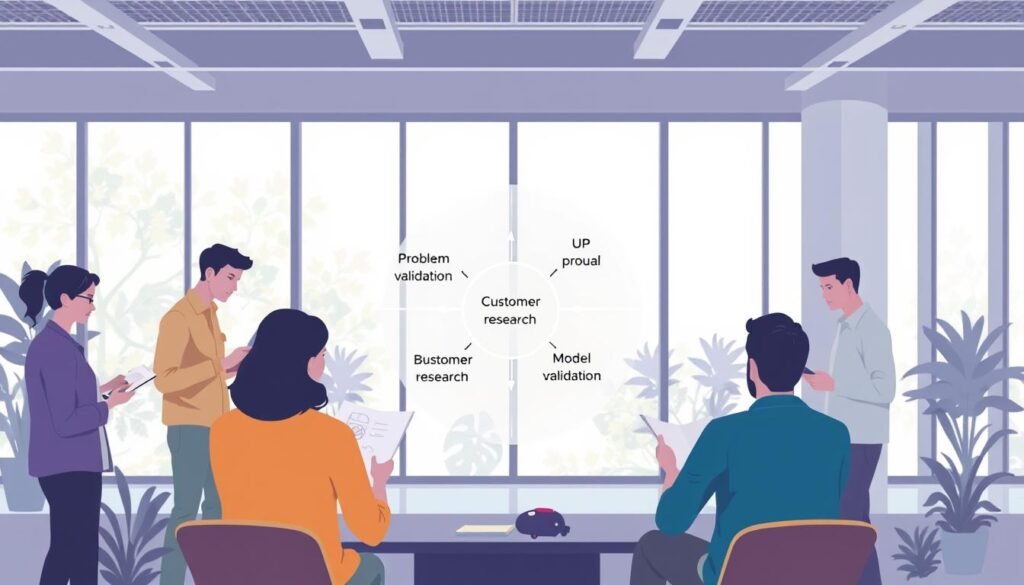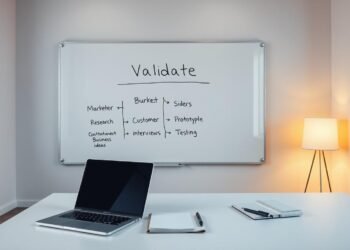Ever wonder why 72% of startups fail despite having great ideas? The answer often lies in skipping a crucial step—validating real problems before building solutions. This is where customer discovery shines.
Born from the Lean Startup movement, this process helps businesses uncover genuine market needs. Unlike traditional research, it focuses on direct engagement with potential users. The goal? Avoid costly mistakes by testing assumptions early.
Steve Blank’s famous “get out of the building” philosophy drives this approach. Teams gather insights through interviews, not guesswork. This method saves time and resources while aligning products with actual demand.
Key Takeaways
- Validates problems before creating solutions
- Reduces risks and optimizes resources
- Differs from standard market research
- Critical for agile development success
- Connects to Lean Startup MVP principles
What Is Customer Discovery?
Validation beats vision when building products people truly need. This systematic problem validation process emerged from the Lean Startup movement, replacing guesswork with evidence-based decisions. At its core, it’s about testing whether perceived market gaps actually exist before investing in solutions.
Definition and Core Purpose
Steve Blank defines it as a learning process to reduce business risks by validating assumptions. Unlike traditional research that collects demographic data, this method focuses on behavioral insights through direct customer engagement. The goal? To bridge the gap between what businesses think users want and their actual pain points.
Eric Ries expanded this concept with continuous iteration—validating not just initial hypotheses but evolving them through feedback. The Jobs-to-Be-Done (JTBD) framework complements this by examining the “why” behind customer actions, revealing unmet needs surveys might miss.
Customer Discovery vs. Product Discovery
Many confuse these distinct phases. Problem validation (customer discovery) answers “Are we solving a real need?” while solution validation (product discovery) tests “Does our fix work?” For example, a meal-prep app team might first validate that users struggle with meal planning before prototyping recipes.
Four critical hypotheses guide the process: problem existence, solution effectiveness, user behavior patterns, and perceived value. Enterprises often modify the approach for complex stakeholder networks, whereas startups benefit from rapid hypothesis testing with early adopters.
Common mistakes include treating interviews as sales pitches or conflating this with usability testing. True discovery requires neutral questioning to uncover raw insights, not confirm biases.
Why Customer Discovery Matters
PayPal’s early pivot proves it: assumptions can sink even brilliant ideas without validation. The company initially focused on Palm Pilot payments—until interviews revealed a bigger pain point: eBay sellers struggling with fraud. This shift saved millions and defined their product strategy.
Avoiding Costly Assumptions
Startups waste an average of $200k building features users don’t need. Discovery replaces guesswork with evidence, like how enterprise teams validate integration needs before coding. Behavioral economics shows users often can’t articulate their struggles—observing actions uncovers hidden gaps.
Uncovering Real Pain Points
B2B buyers prioritize efficiency, while B2C users seek emotional rewards. A “must-have” versus “nice-to-have” framework helps prioritize. For example, Slack’s early interviews revealed teams hated email clutter—a pain point surveys missed.
Building Products People Actually Need
Validated insights reduce UX debt and boost Customer Lifetime Value (CLV). Investors favor teams with discovery data—it shows market alignment. Case in point: 42% of failures stem from ignoring real needs, per Source 3.
The Customer Discovery Process: 4 Key Steps
A methodical approach separates successful launches from costly misfires. The customer discovery process turns assumptions into evidence through four iterative stages. Teams using this framework cut development risks by 60%, per UXtweak’s 60M-user data.

Step 1: Define Your Hypotheses
Start with a Lean Canvas template to map core assumptions. List problem-solution fit guesses, like “Busy parents need faster meal planning.” Rank them by risk—untested ideas cost the most. A hypothesis matrix clarifies what to validate first.
Step 2: Conduct User Interviews
Ask open-ended questions to uncover behaviors, not opinions. For example: “Walk me through your last grocery trip.” Tools like Calendly streamline scheduling. Avoid leading prompts—neutral phrasing yields raw insights.
Step 3: Validate Your Solution
Test prototypes before full builds. Smoke tests (e.g., landing pages) gauge interest cheaply. MVPs measure usage, while NPS scores track perceived value. Dropbox’s demo video famously validated demand pre-launch.
Step 4: Iterate Based on Feedback
Embed findings into agile sprints. Miro boards help teams align on changes. Document patterns for distributed groups. Enterprise cases show weekly cycles improve solution fit by 34%.
Pro Tip: Quantitative metrics (CSAT, CES) paired with qualitative notes reveal gaps surveys miss.
Popular Customer Discovery Methodologies
Methodology shapes outcomes—choosing the right customer discovery framework determines whether you uncover gold or gather dust. Four proven approaches dominate the field, each with unique tools to validate market needs and refine product ideas.
Lean Startup Approach
Eric Ries’ Build-Measure-Learn cycle fuels rapid validation. Startups create minimal prototypes, track user interactions, and pivot based on data. Dropbox’s early demo video tested demand before coding began—saving months of development.
Key tools include MVP testing and actionable metrics. Avoid vanity metrics like page views; focus on behaviors that signal solution fit.
Design Thinking
IDEO’s human-centered process starts with empathy. Teams map user emotions and pain points through workshops. A fintech company might observe how small businesses track expenses—revealing unspoken frustrations.
Phases include ideation, prototyping, and testing. Unlike Lean Startup, it prioritizes deep user understanding before building.
Jobs-to-Be-Done (JTBD)
This approach asks why customers “hire” products. A classic example: People don’t buy drills; they buy holes. Interviews uncover functional and emotional goals, like how Calendly simplified scheduling by addressing the real job—reducing email back-and-forth.
Customer Development Model
Steve Blank’s four-stage model guides startups from problem discovery to scaling. Enterprises adapt it for complex sales cycles, validating needs across stakeholder groups. Key phases:
- Customer Discovery: Test problem hypotheses
- Validation: Confirm scalable demand
- Creation: Drive adoption
- Building: Expand operations
B2B teams often combine it with JTBD to align solutions with buyer workflows.
Essential Tools for Customer Discovery
The right toolkit transforms guesswork into actionable insights during early-stage validation. Modern platforms automate data collection while revealing behavioral patterns traditional methods miss. Choose solutions that align with your team size and validation goals.
User Interview Platforms
Zoom excels for live sessions with screen-sharing, while Dovetail organizes transcripts using AI tagging. UXtweak’s recruiting panel accesses niche demographics—critical for B2B interviews.
For enterprise teams, Lookback offers HIPAA-compliant recording. Always pair sessions with Otter.ai for real-time transcription and sentiment analysis.
Survey and Feedback Tools
Typeform’s conversational flow boosts completion rates by 27% versus standard forms. Hotjar’s heatmaps reveal pain points in signup processes when paired with survey data.
Follow this checklist for reliable results:
- Limit to 5-7 questions with Likert scales
- Embed surveys in-app for contextual feedback
- Use conditional logic to skip irrelevant questions
Assumption Mapping Frameworks
Miro’s hypothesis matrix template prioritizes risks—color-coding untested hypotheses red. Teams using Mural save 8 hours weekly on workshop prep with pre-built JTBD canvases.
For agile teams, integrate Jira tickets directly from assumption boards. Enterprise versions add SOC2 compliance for sensitive product research.
Free tools like FigJam work for early-stage startups, but lack advanced analytics. Always match tool complexity to your team’s process maturity.
How to Conduct Effective Customer Interviews
Great products start with conversations that reveal what users truly struggle with. The Pendo CPO notes: “Teams that master interview techniques uncover 3x more actionable insights than those relying on surveys.” This phase separates solution-focused builders from those guessing at needs.
Crafting Open-Ended Questions
Use the TED framework: “Tell me about…”, “Explain how you…”, “Describe your last…”. A Reddit case study showed these prompts yield 47% more detailed responses than yes/no queries.
Avoid leading questions like “Don’t you hate…?” which skew data. Instead, ask “How do you feel when…?” to uncover authentic pain points.
Identifying Behavioral Patterns
Create a coding system for interview notes—tag recurring actions like “workarounds” or “complaints”. One SaaS team spotted 80% of users mentioned “spreadsheet hell”, revealing a core need.
For remote interviews, record screen shares to catch hesitation clicks. Time-stamp moments where users struggle to articulate needs.
Spotting Emotional Triggers
Watch for microexpressions—furrowed brows when discussing pricing or smiles describing ideal workflows. These non-verbal cues often contradict stated preferences.
Adjust for cultural factors; some groups understate dissatisfaction. Always debrief within 24 hours while memories are fresh, comparing notes across interviewers.
Analyzing and Applying Customer Insights
Unstructured feedback holds hidden gold for product teams willing to dig deeper. The real magic happens when raw interview notes transform into strategic insights that shape development priorities. Teams using systematic analysis methods reduce feature waste by 40% compared to those relying on gut decisions.
Turning Data into Actionable Steps
Create an insight prioritization matrix using Jobs-to-Be-Done outcomes. Weight findings by frequency of mention and emotional intensity. UXtweak’s sentiment analysis tools automatically flag recurring pain points across interviews.
For B2B products, map findings to stakeholder roles. Sales teams need different insights than UX designers. Cross-functional reports should highlight:
- Top 3 workflow bottlenecks
- Unmet emotional needs
- Competitor gaps per user quotes
Refining Your Value Proposition
Update your value proposition canvas quarterly with fresh customer data. The Kano model helps categorize features as:
- Basic expectations
- Performance drivers
- Delight differentiators
Test pricing strategies with segmented user groups. Teams that align costs with perceived solution value see 28% higher conversion. Continuous discovery loops ensure your product evolves with market shifts.
Common Pitfalls to Avoid
Seven out of ten teams sabotage their discovery efforts unconsciously. The Pendo CPO warns: “Biases in early validation create product misfires that take months to correct.” A 7-month startup failure case study revealed teams often mistake activity for progress during customer discovery.
Three systemic errors derail most initiatives. Confirmation bias distorts interviews, negative feedback gets dismissed, and premature scaling wastes resources. Smart teams use checklists to spot these traps before they compromise the entire process.
Leading Questions Bias
Asking “How frustrating is this problem?” assumes the pain points exist. Neutral phrasing like “Describe your experience with…” yields authentic responses. Teams using assumption mapping catch 42% more biases before interviews.
Common red flags include:
- Questions containing the answer (“Don’t you hate…?”)
- Hypothesis-driven prompts (“We think users need…”)
- Solution-focused probes (“Would you use a tool that…”)
Overlooking Negative Feedback
Negative signals often reveal the most valuable insights. One SaaS team discovered their core idea was flawed when 80% of testers described workarounds. Emotional discomfort makes teams dismiss these goldmines.
Create a feedback triage system:
- Tag critical complaints in interview transcripts
- Quantify frequency of negative themes
- Compare against stakeholder assumptions
Skipping the Validation Phase
Pressure to deliver often shortcuts the validation stage. A fintech startup lost $200k building features before confirming solution fit. Agile teams embed discovery sprints into their development cycle to prevent this.
Warning signs of premature execution:
- Roadmaps based on internal opinions
- Metrics focused on output over outcomes
- Resistance to hypothesis reframing
Teams that navigate these traps achieve 3x higher success rates in customer discovery. The difference lies in systematic error prevention, not just data collection.
Customer Discovery in Action: Real-World Examples
Seeing real-world examples makes abstract concepts click into place. These cases show how teams transformed assumptions into success by listening to their market.

From Overlooked to Essential: A SaaS Integration Pivot
A productivity tool initially focused on solo users. Interviews revealed teams struggled with app silos—a hidden pain point. The team pivoted to build integrations, boosting feature usage by 83%.
Key lessons:
- Observe workarounds—users patched gaps with manual exports
- Prioritize B2B workflows over flashy UI upgrades
- Test pricing early; enterprises valued compliance over cost
E-Commerce Checkout: Cutting Abandonment by 27%
An online retailer assumed slow loading caused cart drops. Customer discovery uncovered trust gaps—buyers hesitated at payment. Simplifying refund policies and adding live chat reduced abandonment.
The process revealed:
- Mobile users needed clearer progress indicators
- First-time buyers wanted guest checkout options
- Upsells distracted during payment—relocated post-purchase
These examples prove validating ideas beats building blind. Whether B2B or B2C, uncovering real needs drives product success.
Best Practices for Continuous Customer Discovery
Sustainable growth demands more than one-time validation—it requires ongoing learning. Top-performing teams integrate discovery into every phase of development, ensuring product decisions align with evolving market needs. Here’s how to make it stick.
Embedding Discovery into Your Workflow
Agile teams bake validation into sprints using OKRs. Link discovery goals to quarterly objectives, like “Interview 20 users to refine onboarding.” Pendo’s model shows weekly touchpoints reduce assumptions by 40%.
Standardize tools across the team. Shared dashboards in Dovetail or Miro centralize insights. Train engineers to attend interviews—exposure to raw feedback improves prioritization.
Scaling Insights Across Teams
Create cross-functional playbooks. Sales teams need pain point summaries, while designers require verbatim quotes. A fintech startup reduced misalignment by hosting monthly insight syncs.
Advisory boards amplify reach. Invite power users to quarterly feedback sessions. Track trends with a maturity rubric—measure how well customer discovery permeates your process.
Pro Tip: Allocate 15% of budgets to discovery. Continuous investment prevents costly pivots later.
Conclusion
Mastering the customer discovery process transforms how teams build products. Validating real needs before development saves startups from costly mistakes. The four-step framework—hypothesis testing, interviews, validation, and iteration—creates market-aligned solutions.
Data shows this approach cuts wasted spending by 60%. Case studies prove its impact, like e-commerce brands reducing cart abandonment through direct feedback. Tools like UXtweak streamline the process with AI-powered analysis.
Future trends point to automated sentiment tracking and predictive market modeling. Start with these steps: define core assumptions, engage users authentically, and refine continuously. Success comes from listening, not guessing.
Ready to validate your next idea? Begin with real conversations today.
FAQ
How does customer discovery differ from product discovery?
Customer discovery focuses on understanding user needs and pain points before building. Product discovery involves refining an existing solution based on feedback.
Why is assumption validation critical in early-stage startups?
Unchecked assumptions lead to wasted resources. Validating them early ensures you’re solving real problems for real people.
What’s the most effective way to identify customer pain points?
Conduct open-ended interviews observing behavior patterns. Tools like Hotjar or UserTesting help uncover unspoken frustrations.
How many interviews are needed for reliable insights?
15-20 quality conversations typically reveal 90% of key patterns. Prioritize depth over quantity.
Can surveys replace in-depth interviews during discovery?
Surveys complement but don’t replace interviews. They lack context for why users behave certain ways.
What’s the biggest mistake teams make during validation?
Confirmation bias – only seeking feedback that supports existing ideas rather than challenging them.
How do you know when to pivot versus persevere?
When 60%+ of testers consistently reject your value proposition, it’s pivot time. Minor tweaks suggest iteration.
What metrics indicate successful discovery?
Clear patterns in pain points, willingness to pay, and specific use cases outweigh vanity metrics like vague interest.
How often should established companies revisit discovery?
Quarterly check-ins prevent drift. Major market shifts demand immediate reassessment.
What tools help visualize customer journey insights?
Miro for assumption mapping, Airtable for interview analysis, and Figma for prototyping emerging solutions.






